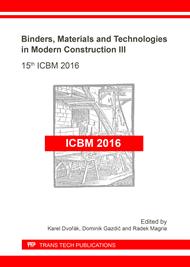p.100
p.106
p.111
p.118
p.123
p.129
p.134
p.139
p.145
Development and Research of Thermal-Acoustical Insulating Materials Based on Natural Fibres and Polylactide Binder
Abstract:
Recently natural fibres are becoming more and more popular and their significance to the industry is increasing as well. In the last two decades, natural fibres are more widely used in the production of thermal–acoustical insulating materials. It was brought to attention that these fibrous materials have good thermal and acoustical properties in comparison to glass fibres. Also, the product, made from natural fibres, can be recycled for several times, and eventually, easily utilized, when it becomes non- recyclable. Therefore, in order to implement such innovative solutions in environmental and building sectors e.g. to install energetically effective thermal–acoustical insulation materials in building industry, scientific research is required. The object of this research is to produce fibrous composites made from natural fibres (hemp fibres and sheep wool waste) and binder of polylactide fibres, which are made from plant products – corn – by biotechnological method. In current research thermal conductivity and sound absorption coefficient of fibrous composites were determined. The microstructure of fibrous composites were investigated as well. The paper describes the manufacturing possibilities with regard to thermal–acoustical insulating materials based on hemp fibres and sheep wool waste from easily renewable material resources provided by the agriculture.
Info:
Periodical:
Pages:
123-128
Citation:
Online since:
October 2017
Authors:
Price:
Сopyright:
© 2017 Trans Tech Publications Ltd. All Rights Reserved
Share:
Citation:


